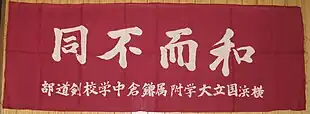
A tenugui (手拭い), is a traditional Japanese hand towel made from cotton. It dates back to the Heian period or earlier. By the Edo period, tenugui became what they are today; about 35 by 90 centimetres (14 by 35 in) in size, plain woven, and almost always dyed with plain color or some pattern. The long sides are finished with a selvage, while the short sides are left unfinished to allow fraying.[1]
A tenugui may be used as a flannel (washcloth) or dishcloth.[2][3] They are often used as souvenirs, headbands, decorations, or for wrapping bottles and similar items.[4] Towels made from terry cloth have largely replaced tenugui in household use. However, tenugui are still popular as souvenirs, decorations, and as a head covering in kendo, where it functions as a sweatband and provides extra padding beneath the headgear (men).[5]
References
- ↑ Rich (7 May 2014). "Tenugui: A Cloth Without Limits". Tofugu. Tofugu LLC. Archived from the original on 21 June 2020. Retrieved 21 June 2020.
- ↑ Bloom, Gary. "What Is a Tenugui". Kyoto Collection. Retrieved 3 April 2023.
- ↑ "How to use Tenugui: Let's use it in the kitchen". Kamawanu (in Japanese). Retrieved 3 April 2023.
- ↑ "Choosing a Japanese Tenugui Towel". Japan Objects. 27 July 2018. Retrieved 3 April 2023.
- ↑ The Official Guide for Kendo Instruction (2nd ed.). All Japan Kendo Federation. 10 March 2020. p. 183.
External links
- YouTube: Tenugi displaying an easy method for tying a tenugui for kendo practice.
- YouTube: All Japan Kendo Federation video I (1/3) 04:28 – 05:20 displaying two other methods for tying a tenugui for kendo practice.
- Flickr: Star Wars themed tenugui displaying an example of a tenugui.
- Tofugu, Tengui: A Cloth Without Limits An article describing tenugui in detail.
- Dayman, Lucy (27 July 2018). "Choosing a Japanese Tenugui Towel: All You Need to Know". Japan Objects. Archived from the original on 21 June 2020. Retrieved 21 June 2020.
